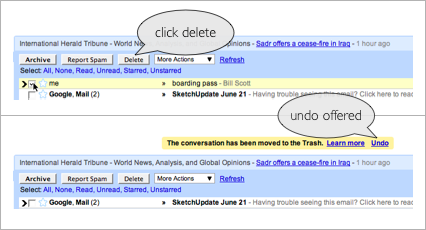Anti-Pattern: Pogo Stick - Google Blogger vs. Backpackit
In my previous article I ranted about Google Blogger. Let me rant some more :-)
Besides being a good example of the One at a Time Anti-Pattern it is also a good example of the Pogo Stick Anti-Pattern (I first heard this term from Jared Spool). I define it as:
Requiring the user to go down a level or two, perform an operation, come back to the top and then have to go back down again. The name comes from hopping up and down through the site.
In the Google Blogger example I described the process of deleting comments requiring a multi-step process:
Pogo Sticking in Google Blogger
It takes three page refreshes to complete the operation and return to where you started.
Compare this to the way you can delete in Backpackit.
Backpackit provides an in page one step delete
What to do about delete confirmation?
- Don't provide one. If the item is trivial (like an item in a list) you can just let the user delete it without bothering them with an idiot box (pointless confirmation).
- Provide one. In Google Reader they use the standard Alert mechanism. This is less than desirable since depending on the operating system the confirmation can appear far away from the deleted item. On the Mac, the alert slides out under the title bar which forces the user to move the mouse far away from the delete operation. Another approach is to provide a lightweight overlay (with a DIV or iFrame) to confirm the delete. They can appear quickly and in context with the operation.
- Provide an Undo. Google does this in several of its products. In Google Mail if you delete a mail message you get a chance to undo the delete.

Deleting mail messages can be undone in Google Mail
This is a clever way to present a one-time undo by tying it to status messaging (along with contextual help).
By using a direct In Page Action pattern, the Pogo Stick Anti-Pattern can often be eliminated.